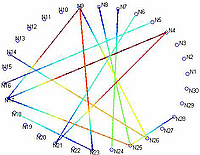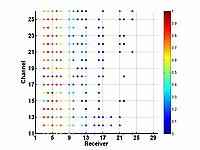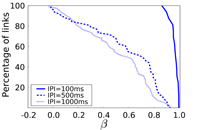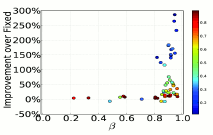Introduction:
While there have been many advances in wireless communications theory and
low-power protocol design, in practice the two fields see little overlap.
This project focuses on filling that gap.
We specifically focus on understanding low power wireless link behavior, how and
why they behave differently than theory would suggest, and evaluating approaches
to adapt and extend theoretical models so that they can be helpful in system
and protocol design.
The goals of this project are:
- to study low power wireless link behavior,
- to understand the root causes of packet success and failure,
- to evaluate how best those causes can be predicted or detected,
- to understand the implications of observations from this study to wireless networking protocols, and
- to adapt existing theoretic models for realistic analysis and simulations.
You can download all of the packet trace data sets we have used in our studies.
Background:
Low-power wireless is increasingly important to computer networking. As Moore's Law has pushed the
price and form factor of computers down, networks have expanded to include large numbers of wireless
desktops, laptops, palmtops and cellphones. This trend towards smaller, lower power, and more numerous d
evices has led to new wireless physical and data-link standards to support them, such as 802.15.1, 802.15.4
and 802.15.4b, which are designed for short range personal area networks (PANs). Economies of scale may make
PAN devices more numerous than any other class of networked node.
A special class of PANs is the 802.15.4, which is the IEEE PHY-MAC standard for low power low data rate
networks. There are many 802.15.4-compliant nodes available in the market that are flexible and provide
access to various physical layer parameters as need be. The flexibility includes turning ON/OFF the CSMA,
adapting transmit power and channel on a packet-by-packet basis, sampling the signal strength even when
packets are not received (useful to measure background noise), etc. This flexibility makes this class of
nodes attractive for experiments that can give us more insights in to the link behavior than is possible
with other classes of wireless nodes.
Experiments, Motes and Testbeds:
Our experiments involve 4 different 802.15.4 nodes: MicaZ, TelosB, Tmote and EM2420. In all our experiments,
nodes register packet sequence number, received signal strength indicator (RSSI) and chip correlation indicator
(CCI). In some experiments, the nodes also sample the RSSI register even when packets are not received. We use
such samples as estimates of background noise. We use several tetsbeds to run our experiments including Mirage,
Omega, MoteLab, and other ad-hoc testbeds set up on the 3rd floor of Gates Hall and in Lake Lagunita of Stanford.
Observations:
We have made several observations. Some of these observations are well-known phenomena in Wireless Communications.
However, we take the "node’s-view of the channel" approach as opposed to human-view of the channel. In the node’s-view
approach we use parameters measured by the nodes for our observations as opposed to using measurement tools such as
Spectrum Analyzers. This approach allows for the nodes to potentially make inference of the changes in the channel in
the future after deployment through actual data and control packets. This approach also is useful in understanding
factors that differ from node to node: noise floor at different nodes are quite diverse. Other observations we make
give us insights in to some phenomena frequently observed in any wireless experiments such as asymmetry and transition
region. We believe that our observations provide mechanisms for nodes to understand the channel and potentially react
to changes in the channel.
Some observations:
(i) RSSI has good predictive value.
(ii) Single CCI reading does not effectively estimate an intermediate link.
(iii) Channel 26 is more immune to 802.11b noise than other channels.
Stanford Wireless Analysis Tool (SWAT):
We have developed a measurement and analysis tool called the Stanford Wireless Analysis Tool (SWAT) that automates gathering and analysis of wireless network measurements. We have made it available for the public to easily download and run measurement experiments in their own testbeds.
Publications:
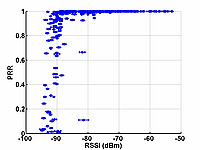
|
[1] K. Srinivasan and P. Levis, "RSSI is Under Appreciated," Proc. of the Third Workshop
on Embedded Networked Sensors, EmNets 2006, Boston, MA, May. 2006. [Data]
|
|



